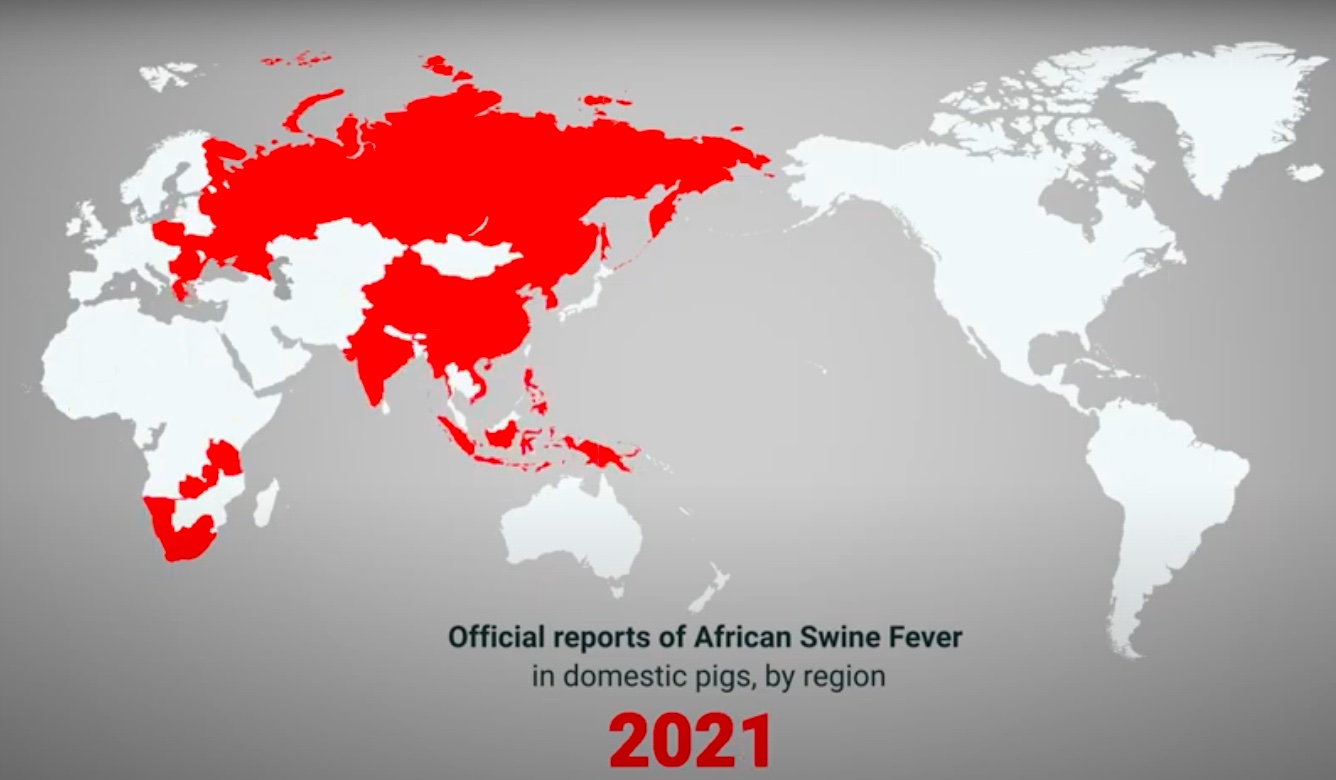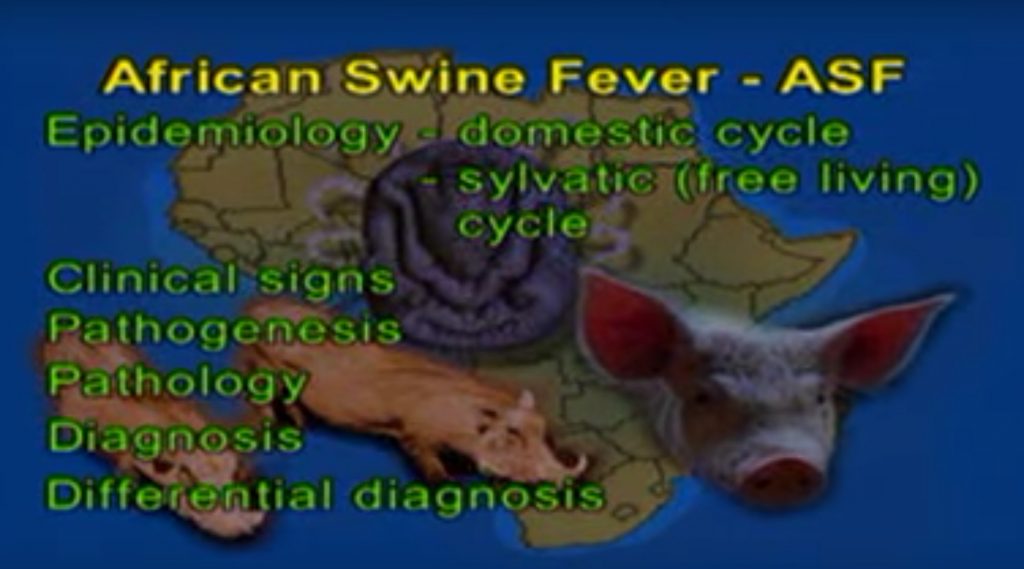
African Swine Fever has been is a viral pork desease that has been around for over a century. But today’s impact in the global meat trade, not only pork meat, is immense. The only good news about African Swine Fever is that it does not affect humans.
African Swine fever causes the death of porks in a few days, and it is highly contagious to other pork, causing normally the farm to kill all pigs.
African Swine Fever originated in Asia, and it is an endemic desease of certain species of feral swine, like warthogs. In turn, warthogs are normally contaminated by soft ticks called tampans, African eyed tampan or Kalahari sand tampan; or by contact with other sick warthogs. The ASF does not affect warthogs, by it is lethal for their domesticated cousins, the common pig.
The desease was transmitted to pigs when they were first in touch with warthogs in Africa. Infected pigs travelled to different continents and transmitted the desease to other domestic pigs, and to local feral pigs like the European wild boar, and the feral pigs that practically roam around bushes and woods worldwide.

However, the most common pig farm ASF infection cause now is contaminated feed. Most of the infections happen when pork feed contains rests of contaminated pork meat and processed carcasses. In less urban areas, when pig farms are open/traditional, the contact with feral pigs, wild boars and warthogs are also a usual cause of infection and the wild species eat the domestic pigs’ feed and drink the same water. ASF infected secretions are another important contamination mean.
Where can ASF virus be found and how long does it live

ASF virus can live for days in pig feces, months in contaminated pig pens, years in frozen pork carcasses and it can also be present for over 140 days in hams, sausage and other dried pork products.
ASF Meaning

ASF means African Swine Fever or African Swine Flu (Influenza). ASF is the acronym used in English language to refer to African Swine Fever for the sake of simplicity.
ASF It has many aspects in common with the other pork flus, by ASF has been a lot more mortal and has decimated pork herds around the world.
ASF vaccine
There is no ASF vaccine yet. A number of laboratories worldwide are working on it as there is a clear economic incentive in combating such a massive animal protein killing desease. Harbin Veterinary Research Institute is working in one of the most advanced ASF vaccine projects, with encouraging laboratory results. But is not clear yet when the vaccine is gonna be approved and ready for commercial use.
African Swine Fever affected countries
African swine fever emerged in domestic pigs in East Africa from infection by warthogs early in the 20th century. Since then, the disease has spread through sub-saharan Africa and has twice moved into Europe. In Africa, ASF remains a recurrent problem, in almost all the sub-saharan countries.
The first ASF infection in Europe and Americas is thought to be originated in West Africa, at the former Portuguese colony of Angola. In 1957 and 1959, from Angola, the virus jumped to Portugal in the trading currents connecting the former colony with Lisboa. From Portugal, the ASF virus colonized Spain, and then a great part of Europe like France, Italy, and The Netherlands.
Due to the trade between Europe and the America’s, the virus travelled to Spanish and Portuguese rooted countries in the Caribbean and tropics (Cuba, Santa Domingo, Brasil).
ASF virus was historically and is currently confined to the African continent with the exception of the island of Sardinia that forms part of Italy however its potential to devastate domestic pig industries in other parts of the world was amply demonstrated by its arrival probably from Angola in Portugal in 1957 and again in 1959 it rapidly became established throughout the Iberian Peninsula and subsequently spread periodically to other European countries and across the Atlantic to Cuba Brazil and the island shared between Haiti and the Dominican Republic.
Due to the lack of cure or vaccines, whole pork farms had to be euthanized. Also, carcasses of euthanized pork needed to be disposed in controlled way, as the virus can live for a long time on deceased porks. Incineration and other bio-hazard security measures are needed to dispose of ASF infected carcasses. In Spain and Portugal, it took 30 years to eradicate ASF.
The second European incursion occurred in Georgia 2007 it has subsequently spread to Europe, including the Baltic States and Poland, but other countries were infected too.
In 2007, the virus actually spread from Africa into the Republic of Georgia, and now more recently has spread to China and further into Southeast Asia, as well as pressing west going into Eastern Europe.
ASF needs active surveillance for the disease, as well as monitoring of epidemics contingency planning to enable early warning and rapid reaction if necessary.
In vulnerable areas in parts of Africa that is suited to raising pigs and where pork consumption is traditional, namely large parts of southern Central East and western Africa, ASF is an increasingly important constraint to agricultural development and food security. This is particularly so in the peri-urban areas of many large African cities where the provision of affordable high quality protein is so difficult.
Better methods to control the disease in modern farming systems as well as in systems where the pigs are required to scavenge are therefore vital and will have to be developed in Africa because ASF is primarily an African problem.
Countries infected with African Swine Fever in 2020
In addition to the African countries, where ASF infections remain rampant due to the large population or feral swine (warthogs), and the lack of controls due to poverty, the following regions and countries remain infected with African Swine Fever in 2020:
African Swine Fever in Europe 2020
The European countries affected by African Swine flu in 2020 are:
- Georgia (not EU) – from 2007
- Russia (not EU) – from 2007
- Ukraine (not EU) – from 2012
- Belarus (not EU) – from 2013
All these countries are not part of the European Union, but share a wide territory with EU neighbors where wild boars roam. Also, these Eastern Europe countries were not collaborative and presumably have not reported all of the ASF outbreaks.
The vires went cross border and contaminated EU countries as follows:
- Latvia from 2014 (pigs and wild boars)
- Estonia from 2014 (pigs and wild boars)
- Lithuania from 2014 (pigs and wild boars)
- Poland from 2014 (pigs and wild boars)
- Czech Republic from 2017 (wild boars)
- Romania from 2017 (pigs)
- Hungary from 2018 (wild boars)
- Belgium from 2018 (wild boars)
- Bulgaria from 2018 (wild boar and pigs)
- Slovakia from 2019 (pigs)
African Swine Fever in Asia 2020
The last wave of ASF reached China in August 2018, probably from Eastern Europe or Russia. From China, the pork flu extended to neighboring Mongolia at the beginning of 2019. By March 2019, the ASF had officially infected swine in Cambodia and Vietnam, other two large markets, together with Philippines (officially informed in October 2019). It is presumably present in other obscure Asian countries like Birmania and North Korea.
African swine fever has never been in the United States or Argentina, so far at least. But affected these markets through the soybean / price precio de la soja due to reduced demand of both soybeans and soy meal for a substantially smaller pork herd.
African Swine Fever symptoms and virus
African swine fever is a hemorrhagic disease of swine. It is caused by African swine fever virus. It’s highly adapted to wild pigs, warthogs and bush pigs in sub-Saharan Africa, where it cycles between those wild species transmitted by soft ticks. That’s the natural life cycle of the virus in the African bushes. But once the wild boars of Europe were infected, the same happens with wild boars in Eastern Europe.
African swine fever is a large and complex icosahedral virus with a DNA genome it causes an extremely severe contagious hemorrhagic disease that’s usually fatal for all infected domestic pigs and wild boar
Clinical African Swine Fever symptoms include high fever, lethargy, loss of appetite, bloody diarrhea, vomiting and abortions, but sometimes sudden death will be the only clinical sign in pigs.
The virus can spread through direct contact with infected world and domestic pigs all through the bites of some soft ticks species which are an important part of the infection cycle of warthogs in East Africa
African swine fever can also be spread by feeding infected pork or pork products to pigs.
Can Africa Swine Fever infect humans?
The short answer is no. There is no scientific evidence of ASF transmitted to humans. Even in infected countries, where probably humans have consumed infected pork meat because of lack of controls and poor food safety, there was not indication of any effect on humans. Same thing with other domestic species, ranging from beef cattle or pets like dogs.
The health challenge ASF poses
There is currently no vaccine for African swine fever. Early diagnosis and culling of infected pig herds are essential to stop the disease from spreading. Feeding food scraps and catering waste to pigs is illegal, a measure which is key for preventing disease in addition to practicing good biosecurity.
The virus is very stable and exists in high concentrations in urine, feces and blood, secretions from infected animals or infected carcasses can be a source of infection for weeks or even months depending on temperature disease
Control is made harder by the large numbers of infected wild boars in Europe. This, coupled with a lack of a vaccine makes this a high priority for scientific research.
Pirbright scientists and other laboratories around the world are currently developing a genetically modified vaccine by deleting virus genes that are thought to prevent the pig’s immune system from fighting infection. By removing these genes the pig’s immune system can respond to the modified virus and the infected pigs show little signs of disease.
African swine fever research on African swine fever virus must be carried out in specialist high containment facilities to ensure the virus is not released into the environment.
The Pirbright Institute is the national and world Organization for Animal Health reference laboratory for African swine fever virus, and contributes to its control by providing diagnostic services and advice.
The origin of African Swine fever in African warthogs
In a poor continent like Africa, lacking domestic animal protein, the ASF is a serious factor limiting pork meat production in a fast population growth part of the developing world.
In Africa, ASF is endemic to most regions and many countries south of the Sahara, from Angola in West Africa to Mozambique in East Africa. Since the mid-1990s the number of countries in sub-saharan Africa facing severe problems caused by ASF has expanded dramatically especially in West Africa, especially in countries with the larger domestic pig herds.
African Swine Fever cycles in Africa
The ASF in Africa has two different cycles, one is the infection between swine, like everywhere else, and the other one is through the tampans (ticks) that transmit the virus and bite warthogs.
It is important to remark that the virus can be transmitted from tick to tick, and from swine to swine (in addition to tick-to-swine). It is one of the virus to make such a trick.
The tampans, Kalahari sand tampan or African eyed tampan is an invertebrate that hosts the ASF virus. The sylvatic cycle has been around probably for centuries, as the ticks biting the warthogs did not affect them.
Other African wild swines, like the bush pig, is immune to the virus, but plays an important role transporting the ticks and the virus elsewhere. Warthogs spend their nights in underground burrows that they leave during the day to forage. Burrows are often situated at the basis of termite mounds where termite eating animals have initiated the excavation, but any other suitable cavity may also be occupied by warthogs and pipes employed for road culverts.
Female warthogs often live in groups consisting of their youngest offspring, generally two to four month old, and one or two yearlings born to them a year previously, as well as one or two other adult females and their offspring. Warthog males live apart from females as individuals or in small groups for the greater part of the year except during the mating season.
Newborn warthogs spend about a month in the burrow before beginning to accompany their mothers on foraging expeditions. It is within these first few weeks of life that warthogs generally become infected with a African Swine Virus by ticks feeding on them, who share the same burrow.
The infection happens despite the fact that the baby warthogs usually acquire antibodies to the virus in colostrum obtained from their mothers within a few hours of birth.
During the acute stage of infection with ASF virus in warthogs which lasts about a week, the large virus populations are sufficient to infect.
Ornithodoros savignyi, known as sand tampan, African eyed tampan or Kalahari sand tampan, is one of some 37 species in the genus Ornithodoros and is a soft tick with a leathery, mammillated integument, causing paralysis and tampan toxicosis, two unrelated conditions. The sand tampan is an ectoparasite on humans, their livestock and wild animals, including birds and bats. Occurring in semi-desert areas of Africa, Saudi Arabia and other parts of the Persian Gulf, India, Sri Lanka and into Asia, it is able to survive for lengthy periods without feeding, spending most of its life burrowed under sand or loose soil, often in wait for animals that rest or sleep under trees or in the lee of rocks, but also in places where people or their animals congregate such as marketplaces, places of worship, cattle kraals and village squares. The timing of its activity is geared to coincide with that of potential hosts, but hot sunny conditions are usually avoided.[2] Because of its habit of feeding and dropping from its host, adult dispersal is limited, whereas larvae may remain attached to their hosts for several days.[3] During its life cycle it will feed on multiple hosts between moults.[4]
Source: Wikipedia
The terrifying transmission of ASF between tampan ticks and animals
These species of Tampan ticks do not remain attached to their hosts for long periods because they are able to engorge blood rapidly, usually in less than an hour.
The tampan ticks therefore spend most of their time in cracks and crevices in the walls and roofs of burrows or in the soil of the burrow floor.
When the warthogs are asleep at night the tampans climb onto their bodies and engorge before dropping off to return to their hideouts.
While sucking the warthog’s blood, they begin to excrete a fluid from glands at the base of the forelegs in order to concentrate on pure blood and less water. While feasting on blood, they also secrete a white guanine fluid, their urinary wast.
The sand tampan feces are never excreted. They are stored in the tick’s body until death because these ticks have no elementary opening.
The pork flu virus is transmitted to warthogs in the saliva of ticks, but the coxal fluid and guanine also contain infectious virus and could induce infection if they were to contaminate a cut or abrasion on the skin of the warthog.
Female tampons, which may be as large as medium-sized buttons lay clusters of round brown eggs a little larger than a pinhead after each blood meal.
The ticks eggs hatch into small pale brown larvae, with only six legs that moat without feeding and become first stage nymph. In the next phase, with their eight legs, the nymph needs to find a blood meal in order to moult into the following stage.
The tampan cycle continues for five nymphal stages, and the next change gives rise to adult males and females.
ASF virus is transmitted in at least three different ways:
- Transovarian
- Transtadial
- Sexual transmission
It implies that a small proportion of larvae that have never fed may be infected with a ASF virus and all subsequent developmental stages of those ticks are likewise infected.
ASF Sexual transmission in these ticks is interesting in that it occurs from male to female only the reason presumably being that coitus in this species involves the male placing a bag of sperm into the genital opening of the female.
Transmission of African Swine Fever between pork
In Africa, it has been found that the tampans transmitting the ASF live in the corrals where the pigs are protected at night-
The Zero Zone for African Swine Fever is an area in southeast Africa, comprised by regions in three different countries: Angonia at Mozambique, Mchinji at Malaui and Chipata at Zambia. Angola, the Democratic Republic of Congo and Uganda have also shown similar results, and it possible that the situation is all the same with domestic pig production south of the Sahara.
In some of these locations, African Swine Fever tests found high proportion of pigs with antibody to ASF virus, indicating that they have survived infection with ASF virus. However, usually infection of domestic pigs by ASF virus results in an acute and highly fatal disease and the pigs die before they develop antibody to the virus.
It is presumed that there is a cycle of infection between the ticks and pigs that occurs predominantly within the tree trunk and thatch refuges.
ASF virus transmitted from swine to swine without the ticks
It appears that a SF is sometimes endemic in domestic pigs in the absence of ticks.
Outside areas where ASF occurs endemically in domestic pigs that is both in areas where it is maintained in the sylvatic cycle as well as areas free of infection, explosive outbreaks of ASF occur when the infection is introduced into domestic pig populations
Such events are characterized by large-scale mortality in a short period of time and the infection spreads rapidly from piggery to piggery because once the infection is established in domestic pigs it is highly contagious, unlike the situation in warthogs.
Sometimes such outbreaks are self-limiting because so many pigs are killed by the virus that there are not enough individuals left to sustain the infection. Conversely, in other situations the infection is sustained presumably by a steady source of new pigs.
Eventually, some coadaption between the virus and domestic pigs population may occur with or without the agency of ticks, and ASF becomes endemic. The few pigs that survive the acute phase of ASF may be contagious for up to two months, although the virus may be detected in the lymphoid tissues of such animals for up to about 6 months. Long-term carriers probably do not occur, although data on this are inadequate.
Acutely infected domestic pigs are highly contagious because large quantities of virus may be present in all their secretions and excretions. These secretions and excretions are capable of generating fomites and may contaminate vehicles, animal handling facilities and the hands or clothing of people.
The infection may be transmitted indirectly, contaminated feed is often responsible for the spread of ASF, especially untreated organic waste that may contain pieces of pig tissue derived from the carcasses of infected pigs slaughtered to produce fresh or processed pork.
ASF virus that has survived sausage or ham production processes and entered the swine food chain has frequently been incriminating as the cause of epidemics.
ASF virus is relatively stable in the environment and is able to survive for long periods of time if kept cool for example in the slurry that is ubicuos at piggeries.
Biting flies such as the stomoxys species may transmit the infection mechanically.
In domestic pigs infection usually occurs either via the bites inflicted by infected tampons or by ingestion of virus contaminated feed stuffs.
in the latter case initial infection occurs in the tonsils or dorsal pharyngeal mucosa from where it spreads to the mandibular or retro pharyngeal lymph nodes thereafter hematogenous spread occurs and levels of viremia may reach 100 million infectious doses per milliliter of blood
The ASF virus has a predilection for the antigen presenting cells of the lympho reticular system. In acute cases these cells undergo cytolysis while in chronic and sub acute cases these cells become hyperplastic.
This is often accompanied by hypergammaglobulinemia, the cause of hemorrhage, edema and effusion into body cavities in acute cases is complex, but involves thrombocytopenia and platelet aggregation, with concomitant coagulopathy, dysfibrinogenaemia as well as impaired vascular integrity
In outbreaks of ASF in Africa acute disease is characteristic affecting pigs of all ages and very few recover. The incubation period varies between 5 to 15 days for infection transmitted orally, while for transmission by tick bite it is usually four to five days.
Signs and symptoms of ASF in pigs
Death occurs between two to nine days in 90% of cases. The first sign of illness that usually goes undetected is a sudden rise in body temperature to between 41 and 42 degrees Celsius, followed by listlessness and partial or complete anorexia.
This is often soon followed by a swaying gait with apparent weakness in the hind legs.
Within a day or two increasing congestion and cyanosis of the skin, tail, ears, snout lower parts of the legs and abdomen become apparent in white skinned pigs.
The animals become increasingly listless, have rapid shallow respiration and huddled together. Sometimes pig show signs of abdominal pain. They may develop ocular and nasal discharges. Vomiting is common, and some animals become constipated with blood stained mucus on the feces. Others develop diarrhea with fresh or blackened blood adhering to the base of the tail and perineum.
Sows frequently abort early in the clinical course of the disease and at all stages of pregnancy. Animals in extremis sometimes have blood stained and frothy discharges from the nose due to the lung edema which is often the immediate cause of death.
Clinical signs in sub acute cases that is those lasting longer than about three weeks are characterized by irregular remittent fever anorexia and loss of condition. Pneumonia is frequent with coughing and dyspnea, especially after even slight exertion some animals develop cardiac insufficiency that may result in inter mandibular edema and sudden death during forced exercise.
Painful swelling of the joints of the limbs may occur with edema of periarticular tissues, some longer-term survivors become emaciated and may develop areas of necrosis abscesses and ulceration of the skin overlying bony protuberances.
In white skinned pigs purplish discoloration of the skin particularly the ventral abdomen and extremities is usual often accompanied by hemorrhage.
ASF has the potential for rapid cross-border spread, by road, air and sea, especially in poor and developing countries, not only in Africa, but also in Eastern Europe and Asia.







